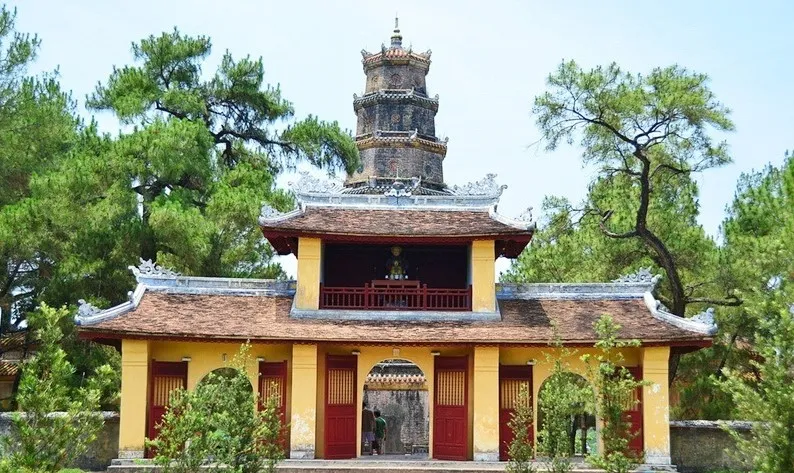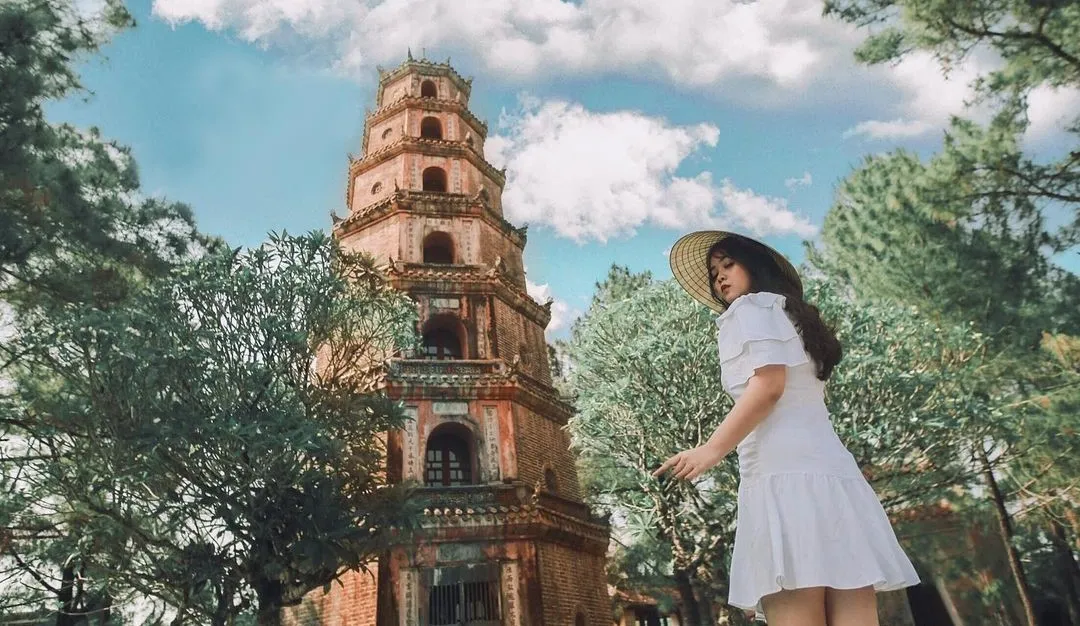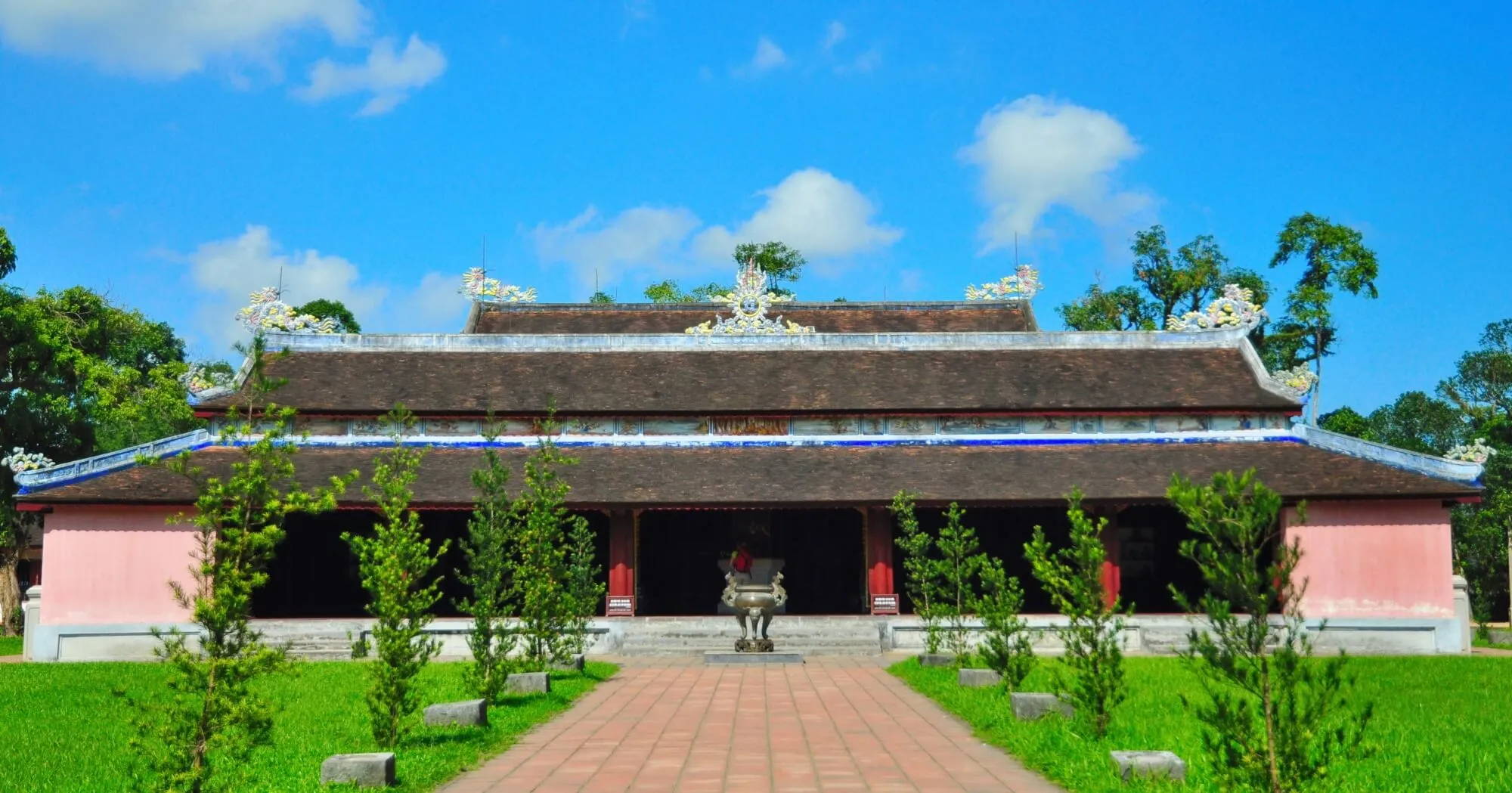Hue, the ancient capital of Vietnam, is not only famous for its majestic tombs and splendid palaces but also captivates visitors with the serene and ancient beauty of its pagodas. Among them, Thien Mu Pagoda, also known as Linh Mu Pagoda, standing tall beside the romantic Perfume River, is considered a spiritual symbol and a must-visit destination in Hue. This pagoda attracts visitors not only with its unique architecture and long history but also with its mysterious stories and peaceful atmosphere, offering tourists unforgettable experiences.
Introduction to Thien Mu Pagoda
Location and How to Get There
Thien Mu Pagoda is located on Ha Khe Hill, in Kim Long ward, Hue city, Thua Thien Hue province. This location is about 5km west of the city center of Hue, making it very convenient for tourists to visit. The pagoda is situated on the left bank of the Perfume River, a prime location with its back leaning against Ha Khe Hill and its face overlooking the romantic Perfume River, creating a picturesque natural setting that captivates the hearts of many.
To get to Thien Mu Pagoda, visitors have several transportation options depending on their preferences and personal conditions:
- Motorbike or Car: This is the most proactive and popular means of transportation. From the city center of Hue, visitors can easily follow Le Duan Street, then turn into Kim Long Street and go straight for about 2km to reach the pagoda. The route is quite easy and well-signposted.
- Cyclo (Rickshaw): Cyclo is a characteristic vehicle of Hue, offering a slow and relaxed experience to admire the city streets. Tourists can hire a cyclo from the city center to Thien Mu Pagoda, both traveling and enjoying the fresh air and beautiful scenery along the way.
- Boat on the Perfume River: Another unique and romantic experience to reach Thien Mu Pagoda is by boat on the Perfume River. Boat tours usually depart from the central city pier or Trang Tien Bridge, taking visitors along the Perfume River, admiring the scenery on both banks and stopping at Thien Mu Pagoda. The boat trip usually takes about 2 hours, offering a different perspective of Hue and Thien Mu Pagoda.
- Bus: If you want to save costs, tourists can choose public buses. There are several bus routes that pass through the Thien Mu Pagoda area, but you need to carefully check the route and stops to ensure convenience for your trip.

Thien Mu Pagoda by the romantic Perfume River
Thien Mu Pagoda reflecting on the gentle Perfume River, creating a picturesque landscape.
History and Name
Thien Mu Pagoda is one of the most ancient and sacred pagodas in Hue, with a history dating back to 1601, during the reign of Lord Nguyen Hoang. According to historical records, during a trip to inspect the Thuan Hoa region to find a location to build a foundation for the Nguyen dynasty, Lord Nguyen Hoang came to Ha Khe Hill. Here, he saw a hill shaped like a dragon turning its head back, a beautiful feng shui location.
Legend has it that local people recounted that an old woman, claiming to be Thien Mu (Heavenly Lady), often appeared on Ha Khe Hill, announcing that a wise lord would come to build a pagoda to gather spiritual energy and strengthen the nation’s vitality. Lord Nguyen Hoang considered this a sacred omen and decided to build a pagoda on this hill, naming it Thien Mu Pagoda, with the hope that the pagoda would fulfill the prophecy and bring prosperity to the country.
However, in 1862, during the reign of King Tu Duc, the name of Thien Mu Pagoda was changed to Linh Mu Pagoda. The reason was that King Tu Duc desired to have a son to succeed the throne, and the word “Thien” in the name Thien Mu (meaning Heaven) was considered taboo, possibly causing bad luck. The king changed the pagoda’s name to Linh Mu, hoping that the sacredness of the pagoda would help him have an heir. It was not until 1896, during the reign of King Thanh Thai, that the pagoda’s name was restored to Thien Mu as originally.
Over more than 400 years of history, Thien Mu Pagoda has witnessed many ups and downs of history, being closely associated with the spiritual and cultural life of the people of Hue. The pagoda is not only a religious architectural work but also an important historical and cultural relic, a symbol of Hue and an attractive spiritual tourist destination for visitors from all over.

Thien Mu Pagoda in the early 20th century
Image of ancient and majestic Thien Mu Pagoda in the early 20th century, marking the passage of time.
Unique Architecture of Thien Mu Pagoda
Thien Mu Pagoda is not only famous for its long history and prime location but also for its unique architecture, bearing the traditional pagoda architecture style of Vietnam, harmoniously combined with the distinctive features of Hue’s imperial architecture. The architectural complex of Thien Mu Pagoda is built on a large area, including many different structures, creating a harmonious, balanced, and majestic overall.
Typical architectural works of Thien Mu Pagoda include:
- Tam Quan Gate (Three-Entrance Gate): The Tam Quan Gate is the main gate leading into the pagoda, built in a two-story, eight-roof style with three entrances. The gate is decorated with intricate patterns, bearing traditional architectural features. On both sides of the entrance are majestic Guardian Statues, guarding the pagoda gate.
- Phuoc Duyen Tower: Phuoc Duyen Tower is the most famous symbol of Thien Mu Pagoda, built in 1844 during the reign of King Thieu Tri. The tower is octagonal, 21 meters high, with 7 stories. Each story of the tower worships a different Buddha. Inside the tower, there is a spiral staircase leading to the top floor, where a gold Buddha statue was previously worshiped. Phuoc Duyen Tower is not only a beautiful architectural work but also carries deep spiritual meaning, being a place of prayer and entrusting faith for Buddhists.
- Dai Hung Shrine (Main Shrine): Dai Hung Shrine is the main shrine of Thien Mu Pagoda, where the main Buddha is worshiped. The shrine is built in the ” trùng thiềm điệp ốc ” (double-layered roof) architectural style, with a massive and solid system of columns and beams. Inside the shrine, statues of Maitreya Buddha and many other Buddha statues are worshiped. Hanging high above is the horizontal lacquered board “Linh Thửu Cao Phong” (Sacred Vulture Peak), signifying the sacredness and nobility of Buddhist law. Dai Hung Shrine is the place where important Buddhist rituals take place and is a space for Buddhists and visitors to worship and pray.
- Quan Am Shrine, Dia Tang Shrine, Huong Nguyen Pavilion: In addition, within the pagoda grounds, there are many other architectural works such as Quan Am Shrine worshiping Bodhisattva Avalokiteśvara, Dia Tang Shrine worshiping Bodhisattva Kṣitigarbha, and Huong Nguyen Pavilion, a place for burning incense and praying. Each work has its own beauty, contributing to the richness and diversity of Thien Mu Pagoda’s architecture.
Besides its unique architecture, Thien Mu Pagoda also preserves many precious antiques of high historical and artistic value such as bronze bells, steles, ancient statues, horizontal lacquered boards, parallel sentences, etc. These antiques not only reflect the long history and culture of the pagoda but also are evidence of the development of Buddhism in Hue and Vietnam.
Discovering Highlights at Thien Mu Pagoda
Majestic Tam Quan Gate
Stepping through the Tam Quan Gate, visitors seem to enter another world, separated from the noise and bustle of outside life. The Tam Quan Gate with its imposing and majestic architecture is the starting point for the journey to discover the beauty of Thien Mu Pagoda. The two-story, eight-roof structure of the gate, along with intricate decorative patterns, shows the talent and skill of ancient artisans. The three entrances through the gate symbolize the Three Doors to Liberation: Emptiness, Signlessness, and Wishlessness, carrying profound meaning in Buddhism.
On both sides of the Tam Quan Gate are Guardian Statues, deities protecting the pagoda, with majestic and imposing appearances, creating solemnity and sacredness for the pagoda space. Stepping through the gate, visitors will feel the serenity and peace spreading throughout the space, preparing their minds for the journey to discover the wonders inside the pagoda.

Tam Quan Gate of Thien Mu Pagoda with unique architecture
Tam Quan Gate of Thien Mu Pagoda, the entrance leading to a serene and sacred space.
Phuoc Duyen Tower – A Symbol
Phuoc Duyen Tower, with its graceful appearance, rising tall in the pagoda grounds, has become an indispensable symbol when mentioning Thien Mu Pagoda. This seven-story octagonal tower is not only a beautiful architectural work but also a cultural, historical, and spiritual symbol of Hue. Each story of the tower worships a Buddha, symbolizing enlightenment and liberation from reincarnation.
Climbing the spiral staircase inside the tower (currently often not open to visitors inside), visitors can admire the panoramic view of Thien Mu Pagoda and the romantic Perfume River from above. Phuoc Duyen Tower is not only an architectural highlight of the pagoda but also an ideal place for visitors to admire the natural beauty and feel the peace and tranquility of the pagoda space.

Phuoc Duyen Tower, symbol of Thien Mu Pagoda
Majestic Phuoc Duyen Tower, the symbol of Thien Mu Pagoda, imbued with historical and architectural imprints.
Solemn Dai Hung Shrine
Dai Hung Shrine is the spiritual center of Thien Mu Pagoda, where important religious activities take place and where Buddhists and visitors come to worship and pray. The shrine is built with ” trùng thiềm điệp ốc ” architecture, creating an ancient and solemn beauty. The space inside the shrine is spacious and airy, with a solid wooden column and beam system and Buddha statues arranged harmoniously and balanced.
The statue of Maitreya Buddha is worshiped in the center of the shrine, with a gentle smile, bringing a feeling of peace and relaxation to visitors. Hanging high above is the horizontal lacquered board “Linh Thửu Cao Phong”, expressing reverence for Buddhist law and the sacredness of the pagoda. Dai Hung Shrine is not only a beautiful architectural work but also a place containing profound cultural and spiritual values, a must-visit destination when traveling to Thien Mu Pagoda.

Dai Hung Shrine, the solemn main shrine of Thien Mu Pagoda
Dai Hung Shrine, the main shrine of Thien Mu Pagoda, where Buddha is worshiped and Buddhist rituals take place.
Serene Arhat Garden
Another interesting destination within the grounds of Thien Mu Pagoda is the Arhat Garden. The statue garden is located behind Dai Hung Shrine, with dozens of Arhat statues carved in various shapes and expressions, creating a lively and attractive space. Each Arhat statue has a unique face and posture, expressing different emotional states of humans, from joy, sadness, anger, resentment to contemplation and reflection.
Walking in the Arhat Garden, visitors not only admire the exquisite sculpture art but also feel the serenity and peace in their souls. The Arhat Garden is an ideal space for visitors to relax, calm their minds, and learn about Buddhist teachings.
Pagoda Grounds and Surrounding Landscape
The grounds of Thien Mu Pagoda are spacious and airy, covered with green trees and flowers, creating a green, cool, and fresh space. Visitors can stroll in the pagoda grounds, admire the beautiful natural scenery, enjoy the fresh air, and feel the peace and tranquility. From the pagoda grounds, visitors can also look far away, admiring the winding Perfume River, the green hills, and the peaceful cityscape of Hue.
The scenery surrounding Thien Mu Pagoda is also very beautiful, with the romantic Perfume River flowing by, rows of shady green trees, and flower gardens showing off their colors. Visitors can combine visiting Thien Mu Pagoda with boating on the Perfume River, admiring the scenery on both banks, and exploring other tourist attractions in the area.
The Historic Car of Venerable Thich Quang Duc
Behind Dai Hung Shrine, a special historical relic is displayed: the blue car that transported Venerable Thich Quang Duc to the intersection of Phan Dinh Phung – Le Van Duyet (Saigon) on June 11, 1963. At that place, the venerable monk self-immolated to protest the Ngo Dinh Diem regime’s policy of suppressing Buddhism.
This car is an important historical witness, reminiscent of a turbulent period in Vietnamese history and the noble sacrifice of Venerable Thich Quang Duc. Visitors to Thien Mu Pagoda cannot help but be moved when seeing this historic car, expressing respect and gratitude to the venerable monk.

The car that carried Venerable Thich Quang Duc displayed at the pagoda
The historic car, which carried Venerable Thich Quang Duc, a relic of profound historical and humanistic value.
Tomb Tower of Venerable Thich Don Hau
At the end of the pagoda grounds, visitors will reach the tomb tower area of Venerable Thich Don Hau, a famous abbot of Thien Mu Pagoda, who made many great contributions to Buddhism and society. The tomb tower is built solemnly and serenely, expressing respect and remembrance for the venerable monk. The tomb tower is also built in a 7-story tower style, although smaller in scale than Phuoc Duyen Tower, it still has unique and solemn architectural beauty.
The tomb tower area of Venerable Thich Don Hau is a meaningful destination in the Thien Mu Pagoda tourism journey, helping visitors learn more about the history and contributions of the venerable monks to the pagoda and Vietnamese Buddhism.

Serene tomb tower of Venerable Thich Don Hau
Tomb tower of Venerable Thich Don Hau, the resting place of the abbot who made many contributions to Thien Mu Pagoda.
Useful Travel Tips for Thien Mu Pagoda
Ideal Time to Visit
The ideal time to visit Thien Mu Pagoda is in spring (from January to March) and autumn (from September to November). Hue’s weather in spring and autumn is usually cool and pleasant, with little rain, very suitable for sightseeing and pagoda visits. Especially in spring, Hue often has many traditional festivals, visitors can combine visiting Thien Mu Pagoda with participating in these festivals to experience Hue culture fully.
Summer (from April to August) in Hue is quite hot and sunny, but this is also the peak tourist season, Thien Mu Pagoda still welcomes a large number of visitors. If visiting in summer, tourists should prepare hats, sunscreen, and drink enough water to protect their health. Winter (from December to February of the following year) in Hue is often rainy and cold, but it brings a unique beauty of contemplation and tranquility. If you like a quiet space, you can visit Thien Mu Pagoda in winter.
Dress Code and Attitude When Visiting Pagoda
When visiting Thien Mu Pagoda, as well as other religious sites, visitors should pay attention to choosing polite and discreet clothing. Avoid wearing clothes that are too short, revealing, or offensive. Choose comfortable clothes that are suitable for the weather and convenient for moving around and sightseeing.
Within the pagoda grounds, visitors should maintain a solemn and respectful attitude. Do not talk loudly, make noise, or cause disorder. Do not smoke or litter indiscriminately. When entering shrines, walk gently, speak softly, and do not touch artifacts or worship items. Maintain general hygiene and protect the environmental landscape of the pagoda.
Combine Visiting Nearby Tourist Attractions
Thien Mu Pagoda is conveniently located near many other famous tourist attractions of Hue. Visitors can combine visiting Thien Mu Pagoda with nearby destinations to explore the beauty of Hue comprehensively. Some tourist attractions near Thien Mu Pagoda include:
- Tu Duc Tomb: Tu Duc Tomb is one of the most beautiful and famous tombs of the Nguyen emperors, located about 3km from Thien Mu Pagoda.
- Bach Ma National Park: Bach Ma National Park is a large nature reserve, with many majestic natural landscapes, waterfalls, and primeval forests, about 40km from Thien Mu Pagoda.
- Hue Citadel: Hue Citadel is a World Cultural Heritage Site, a complex of historical and architectural relics, a symbol of the ancient capital of Hue, about 5km from Thien Mu Pagoda.
- Perfume River: The Perfume River is the symbolic river of Hue, visitors can take a boat trip on the Perfume River, admire the scenery, and listen to Hue folk songs.
Other Notes
- Bring cash to buy entrance tickets (if any), souvenirs, or make donations at the pagoda.
- Bring drinking water, especially in summer.
- Bring sunscreen, hats, if visiting in summer or hot weather.
- Prepare some questions or information you want to learn about Thien Mu Pagoda to ask monks or pagoda managers.
- Research the history, architecture, and rules of the pagoda beforehand for a meaningful and complete visit.
Conclusion: Thien Mu Pagoda – A Must-Visit Destination in Hue
Thien Mu Pagoda is not only an ancient and sacred pagoda but also an attractive tourist destination, imbued with cultural, historical, and spiritual values of Hue. With its prime location, unique architecture, long history, and peaceful atmosphere, Thien Mu Pagoda will surely bring visitors unforgettable experiences and deep impressions of dreamy Hue. If you have the opportunity to visit Hue, do not forget to visit Thien Mu Pagoda to discover the ancient and sacred beauty of this iconic pagoda. Are you ready for this exciting Thien Mu Pagoda travel journey?